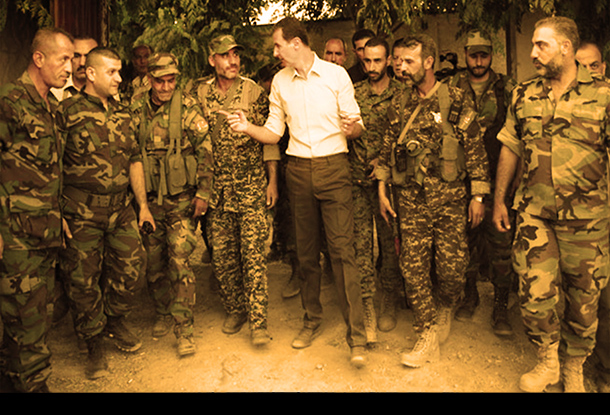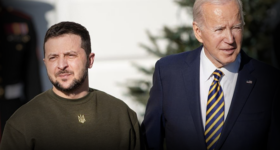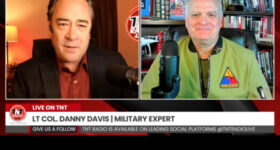
IMAGE: Syrian President Bashar al-Assad on the ground and speaking to Syrian Arab Army officers.
Patrick Henningsen
21st Century Wire
Last night, Kurdish officials in northeastern Syria issued a statement that an agreement has been reached with the government in Damascus allowing the Syrian Arab Army (SAA) to takeover key strategic positions along Syria’s northern border with Turkey.
Not surprisingly, cheers can he heard from Damascus to Moscow, and Tehran too, while leaving Washington’s foreign policy blob visibly moaning in agony.
The reality of the situation is that Turkey sprung a trap set by Damascus and its allies. In doing so, Turkey helped to clean up what was previously a near impossible situation for Damascus.
While much of the western mainstream media has laboured over ‘Trump’s decision‘ to pull-out US troops from Syria, there are other factors which have been driving the current situation. If you’ve been monitoring the Turkish press over the last few years, you would know that Turkey’s President Recep Tayyip Erdoğan has been eager to fire-up his AKP base at home and project Neo-Ottoman power regionally, so this latest Turkish foray into Syria can be seen as a resumption of the ‘New Turkey‘ – the AKP’s gradual transformation of Turkey from a secular Kemalist state, to an Islamic one. This gradual revolution is not confined within Turkey’s own borders though, as it hopes to extend its micro-colonial project of Sunnification to include areas in question located inside and along Syria’s northern border with Turkey. Hence, Ankara has moved its forces into Syrian territory for the third time in as many years, this time dubbed “Operation Peace Spring,” and with Erdogan justifying the move under the auspices of ‘fighting terrorism,’ vowing once again to secure the country’s national security by stamping-out the Kurdish YPG-PKK ‘terrorist threat’ embedded in northern Syria. He may have achieved some marginal success in this department, but not in the way most mainstream pundits think.
Unknowingly perhaps (or not), Turkey helped towards resolving at least three separate problems which had been grating at Damascus and Moscow for at least the last three years. Firstly, the Turkish incursion has finally displaced uninvited US military forces that had begun illegally occupying northeastern Syria since late 2016, effectively propping-up their SDF (Syrian Democratic Forces) Kurdish-led proxy militants, many of whom share membership with Kurdish YPG/PKK militant groups. This weekend has shown the world that without its US protection, Kurdish-led forces are not as viable as they have been depicted in the western media, now exposed to the painful reality that their ‘autonomous’ status in northeastern Syria is on borrowed time, evidenced by the fact that they failed to protect Kurdish residents from the Turkish military and their jihadi vanguard ground forces, formerly known as Free Syrian Army (FSA), who’ve rather cynically rebranded themselves now to the ‘Syrian National Army’. With Syrian Kurdish forces now on their back heels, they were left with no other option than to approach Damascus to negotiate an alliance. That agreement was inked this weekend, with the SAA now heading towards key towns and cities in the northeast of Syria including one of the centers of fighting – the hotly contested Syrian border town of Kobani. This new reality also means that Turkish military will not willingly fire upon SAA forces inside of Syrian sovereign territory, although Turkey’s jihadist FSA/SNA militias might engage with its old nemesis. Those side skirmishes could prolong instability, but they are not nearly as insurmountable as entrenched US forces in the area.
Reports show the SAA’s arrival in these areas as being met with cheers from crowds – which is a public relations disaster for Washington and its Kurdish ‘Rojava’ nation-building project in northern Syria.
Pretty sure CNN and BBC won’t be showing us this footage of Syrians holding huge celebrations in the northern cities of Qamishli and Hasakah to welcome the arrival of #Syria’s Army—the sole defender of the Syrian people. pic.twitter.com/vn8lWdJrwk
— Sarah Abdallah (@sahouraxo) October 14, 2019
Lastly, aside from securing its key northern border crossings, Damascus in now one step closer to reclaiming its oil and gas fields situated north of the Euphrates river near the city of Deir Ezzor – which have been continuously occupied by ISIS and SDF forces respectively since 2014. Liberating its own domestic energy supply will go a long way towards helping Damascus mitigate some of the economic suffering felt as a result of the imposition of joint EU-US sanctions, a punitive embargo designed by western powers to strangle the country and foment more domestic unrest.
A New Middle East
The Kurdish request for Damascus protection also flies in the face of years of western propaganda which tried to justify Washington’s policy of military occupation and nation-building by convincing the world that the Syrian government was unwelcome in the northeastern region of its own country, and that “Kurdish independence” was a fait accompli. Moreover, Damascus is a step closer to securing previously vulnerable stretches of its eastern border with Iraq which the US was previously ‘managing’ and which allowed ISIS to move through and use as a staging ground for attacks further afield in areas like Sweida and Al Tanf. If a mutual security arrangement can be reached between Syria and Iraq to secure its shared border, then this would potentially revolutionise political and economic affairs in the region, and even globally.
If these events do come to pass, it would be a complete defeat for decades of Washington-led efforts in the region. Together with its allies, the US has worked long and hard to keep this part of the Middle East unstable and divided. It was in this US-led, and Saudi and Israeli-engineered environment of destablisation that both al Qaeda and ISIS terrorists were able to emerge and thrive for so long. Its adversaries should remain vigilant though as history demonstrates both Washington and Israel are not above provoking instability in order to achieve their shared short-term and long-range goals for the region.
SEE ALSO: US Work With Russia to Handover Patrols Between Turkish and Syrian Armies in Manbij
Regardless, the board has been flipped in Syria. Unable to either hold territory or keep thousands of ISIS prisoners in custody, US-backed SDF militias have been exposed as the latest in a long lineage of hapless pawns of Washington in the Great Game. Once new ground locations are secured by SAA forces, then Damascus could invite Russian air support to secure this airspace – an outcome which can only mean that terrorists’ days will be numbered going forward. Any remaining ISIS or Al Qaeda terrorists brigades active in north of the Euphrates will have few remaining escape routes, other than north to seek refuge in the various AKP-sanctioned terrorist enclaves located across the border in southern Turkey.
As this author said back in early 2018, the US-Kurdish dance in northeastern Syria was always a game of musical chairs, and sooner or later, someone had to leave. And that someone is the USA and hopefully… immediately followed by ISIS.
As President Bashar al-Assad said already, Syria is determined to reclaim “every inch” of its territory. So it might behoove western powers not to underestimate the will and determination of a country and army which has withstood eight years of a fully internationalised regime change war waged against it.
***
Author Patrick Henningsen is an American writer and global affairs analyst and founder of independent news and analysis site 21st Century Wire, and is host of the SUNDAY WIRE weekly radio show broadcast globally over the Alternate Current Radio Network (ACR). He has written for a number of international publications and has done extensive on-the-ground reporting in the Middle East including work in Syria and Iraq.
READ MORE SYRIA NEWS AT: 21st Century Wire Syria Files
HELP SUPPORT THIS INDEPENDENT MEDIA PLATFORM – BECOME A MEMBER @21WIRE.TV















